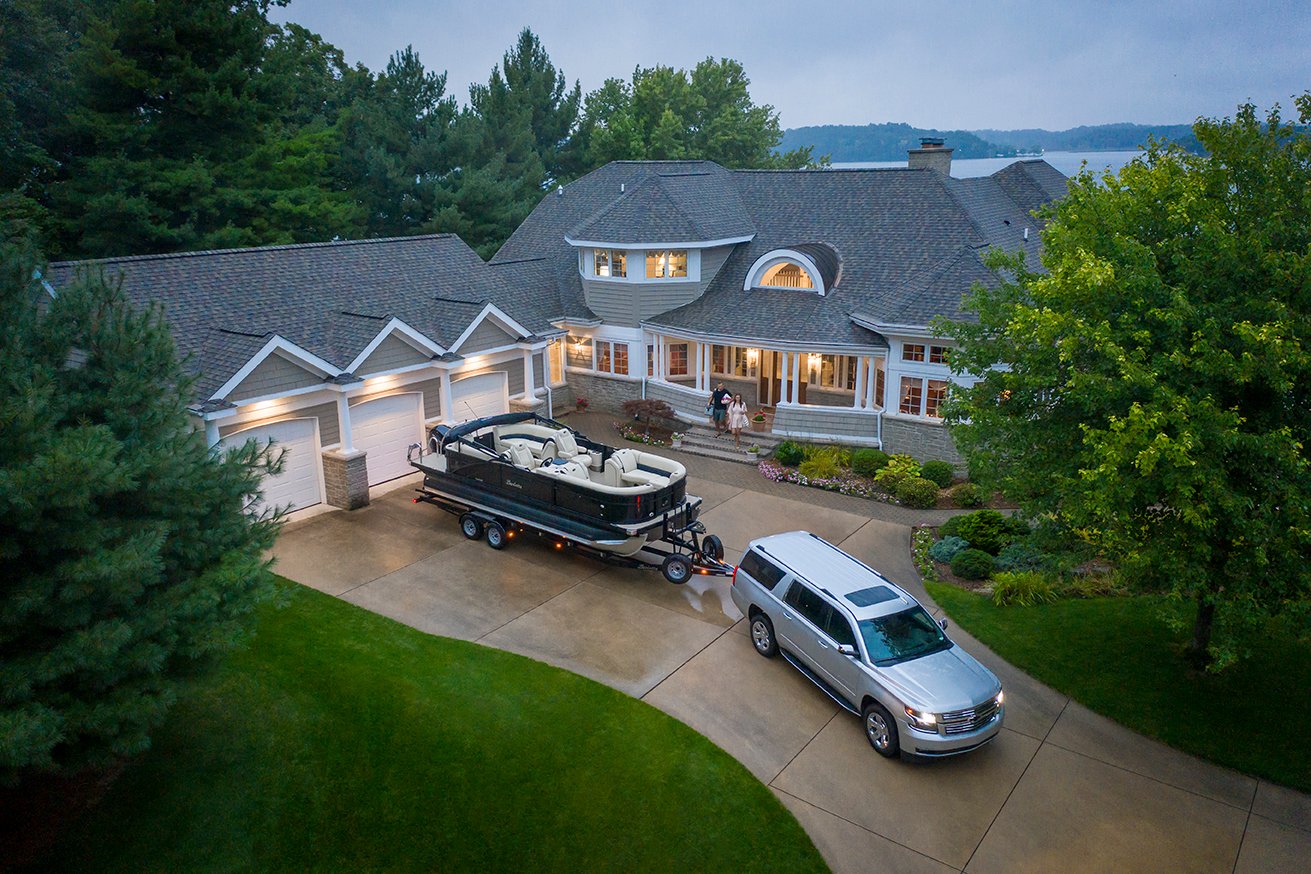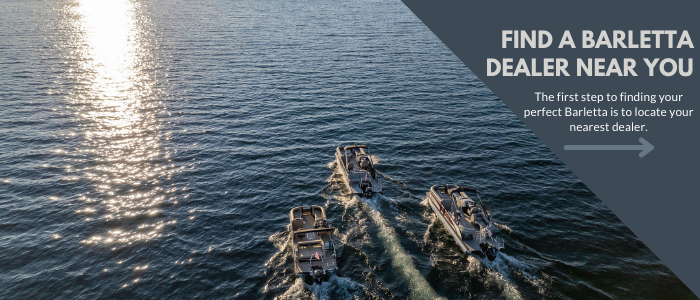How to Trailer a Pontoon Boat: 9 Easy Steps
As a long-time boater, one of my least favorite parts of owning a pontoon boat is having to transport it. I’ve mastered pulling the boat out of the water but towing it down the road took some time to get used to.
In my earlier years of owning a pontoon boat, I would rent a scissor trailer from the local marina. I would use it to pull the boat out with the help of a friend who knew how to back up a truck with the trailer attached. This is also a difficult task if you’re new to boating.
I live in a rural lake town which means I have to travel on lots of windy back roads. If you’ve ever had to pull a pontoon boat with a scissor trailer through such obstacles, you understand why this took me a long time to get used to.
If the thought of trailering your pontoon boat is daunting, you’re not alone. You might be new to boating or could use a refresher on the trailering process. Whichever the reason, it’s led you to this article so let’s walk through the nine simple steps it takes to trailer a pontoon boat.
There are many things to consider before hitting the road with your boat and trailer. Use this list the next time you have to transport your pontoon boat and you’ll be in good shape.
STEP 1: Can your Vehicle Tow the Weight of the Boat and Trailer?
Before you tow your pontoon boat, and I would say before you even purchase a boat and trailer, it is critical to know your vehicle's tow capacity. You must ensure that your vehicle can pull the weight of the trailer plus the boat. I have seen too many people pulling trailers that are far too heavy for their vehicles.
Doing so can damage your vehicle and can be extremely dangerous for the driver and others on the road. You could have trouble stopping the weight of the boat and trailer if your vehicle’s tow capacity is exceeded.
Making sure your vehicle can confidently tow the weight of the boat and trailer will make your travels much easier and safer. It is so important to make sure before you even purchase the boat, that you own or have access to a vehicle that can tow the whole package.
STEP 2: Make Sure the Trailer is Hooked onto the Vehicle Correctly
Once you verify that your tow vehicle is capable of safely towing the trailer and boat, the next step is to connect the trailer to your vehicle. It is extremely important to make sure this is done correctly. All it takes is one mistake when hooking the trailer up to end up with some big problems.
Start by checking your hitch first. Always make sure you are using the correct size ball receiver on your hitch. Most trailers will have information on them that will tell you what size ball is required. Without the correct size ball on your hitch, you will be unable to attach the trailer to the vehicle.
If you’re unsure of the hitch size requirements, check with the trailer’s manufacturer to be sure. When attaching the ball receiver to the vehicle, it’s crucial to make sure the hitch pin is secured. This way the receiver doesn’t slip out of the vehicle’s hitch attachment that’s located on the frame.
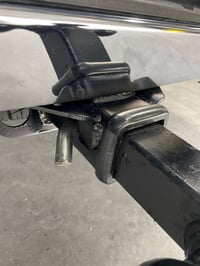
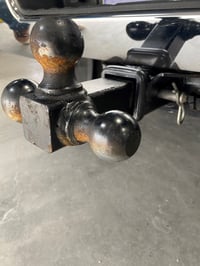
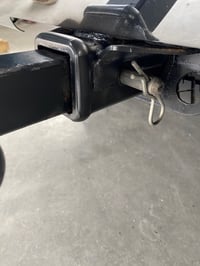
Receiver hitch connected to the tow vehicle with hitch pin secured using the cotter pin
Next, connect the trailer to the tow vehicle. The trailer’s coupler will sit on top of the ball receiver. When placing the trailer’s coupler onto the receiver make sure to first pull the cotter pin out of the lever.
Once the pin is out, pull up on the lever and set the trailer onto the ball receiver. You will lower the trailer onto the ball using the trailer jack. Be sure to put the cotter pin back into the coupler lever immediately after placing the trailer.
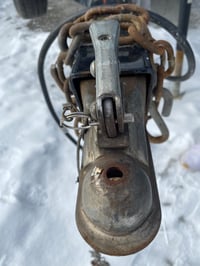
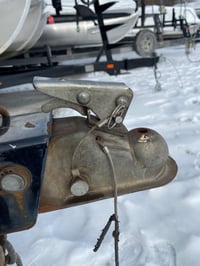 (Left) Trailer hitch coupler (Right) Coupler lever in the down position
(Left) Trailer hitch coupler (Right) Coupler lever in the down position
This pin acts as an extra locking device and will ensure that the lever doesn’t unhitch in transit. Also, the safety chains need to be connected to the vehicle’s frame as an added layer of protection.
Most trucks will have a spot built into the frame specifically for safety chains to hook on. While connecting the chains, make sure to attach the breakaway brake cord to the vehicle as well.
Don’t forget, you need functioning lights on the trailer. There is an adaptor plug that you will need to plug into your vehicle's electrical system. This way you have functioning lights and brakes. The adapter for this plug will vary based on the type of tow vehicle you have. Be sure to check your owner’s manual for the location.
Once the adapter is in, plug in the trailer’s electrical cord. Before leaving with your trailer and boat you want to ensure that the brakes are working. You’ll also want to double-check your lights.
You don’t want to be driving a trailer with no working lights. This is where a co-captain comes in handy. Have someone stand behind the trailer as you test the brake lights and turn signals to ensure they’re working before you hit the road.
Check out Barletta's video on How to Hitch a Pontoon Trailer to Your Tow Vehicle
STEP 3: Position the Boat on the Trailer
Whether you have a scissor trailer or a float-on trailer, the pontoon boat needs to sit correctly on the trailer to make traveling easier and safer. The size of the trailer and the size of the boat will determine where it should be sitting on the trailer.
Let’s start by looking at scissor trailers. These trailers can be longer than your boat and that’s okay, but you have to take extra precautions if that’s the case. If you have a shorter boat, you want to make sure that you don’t pull the boat too far up on the trailer supports.
Doing so can place the transom on the cross-members of the trailer. Positioning the boat like this will elevate the boat above the supports. When the boat rests on its transom, it makes the whole trailer extremely unstable. In this position, the boat can easily topple over going through curves or turning a corner.
It is extremely dangerous to travel like this so you want to avoid positioning the boat too far up on the trailer. You only have to worry about this if you have a bi-toon scissor trailer and a bi-toon boat.
Tri-toon scissor trailers don’t have cross member bars so you won’t have this problem. When positioning the pontoon on its trailer, you also don’t want the boat too far back. If the boat is positioned too far back on the trailer it will cause uneven weight distributions.
The back of the trailer will be very heavy with little weight in the front. Positioning the boat like this will make it susceptible to tipping around corners and at the very least, cause a bouncy ride down the road. When using a scissor trailer, it’s important to position the boat just right so that you have a smooth and safe ride.
Now let’s look at float-on trailers, also referred to as bunk-style trailers. These are typically made custom to fit the size and type of pontoon boat you have, whether it has two toons or three.
The difficult thing with these trailers is making sure that the toons are centered between bunks. This can be hard because the bunks are completely submerged underwater when you load the boat. A helpful add-on that most trailer manufacturers offer are bunk guides.
These guides stick out of the water and help you know exactly where the bunks are. With guides, you can pull the boat straight onto the trailer much easier. Always double-check to make sure the toons are straight over the bunks before completely pulling it out of the water. Then, pull the boat out slowly so you can check that it’s straight.
[For more information on pontoon boat trailers check out: Pontoon Boat Trailers: The Ultimate Buyer’s Guide]
STEP 4: Strap the Pontoon Down
Once the pontoon is lined up correctly on the trailer, the next step is to make sure it’s strapped down. Depending on what trailer you have will determine what you need in order to do this. If you have a scissor trailer, you will want to purchase a heavy-duty ratchet strap.
It’s important to have a long ratchet strap that you can put around the front of the trailer. You will be able to hook the strap to the two lifting eyes on the front of the toons connecting them to the trailer frame. A heavy-duty strap is recommended so that it can hold the boat steady without snapping.
If you have a bunk-style or float-on trailer, the strap comes with the trailer. Just be sure to hook the strap to the boat and tighten it as much as you can, then you’ll be ready to go.
Now you have all the tips and tricks on how to safely prepare to travel with your boat on a trailer. There are just a few last things to go over before you head out on the road.
STEP 5: Learn How to Back Up a Trailer
I would strongly advise getting lessons from someone who is skilled at backing up trailers. This can be one of the most difficult parts of towing a boat.
After having a professional teach you the basics, it’s a good idea to practice on your own. I recommend finding a large open area such as a vacant parking lot. Practice until you’re confident enough to back up into the water at the boat launch.
Backing a trailer up can be scary if you’ve never been taught how to properly do it. Having someone skilled in this area teach you how to do it will get you started on the right foot.
STEP 6: Have All of your Gear in the Boat Ahead of Launch
Before you leave the storage facility with your pontoon, make sure to have all of your boating accessories and gear in the boat. Make a list ahead of time and load the boat before you go to the launch. There’s nothing worse than holding up a line of boats at the local ramp because you forgot to stow the lifejackets under the seats.
Think of other items you will need for your outing and store those away ahead of time as well. It’s much easier to load the boat before getting to the launch. Planning ahead will make this process much smoother. Before you take off, make sure all gear is stowed away or strapped down so it doesn’t fly out in transit.
STEP 7: Drive Cautiously
Boats are awkward and top-heavy on any trailer. You should drive accordingly. It’s always good to take corners wide and slow. You don’t want to end up with your boat on its side in the middle of the road.
Another thing to remember is that you need to give yourself extra room to brake. The weight of the boat and trailer will make sudden stops more difficult. It’s always good to give yourself a lot of room to stop.
Another tip is to be aware of what is going on around you. I know, you’ve probably heard this a million times. I can’t emphasize it enough when trailering a boat. Driving with a trailer can create extra blind spots. Take your time and know where your trailer is. Not only is this for your safety but it’s also for everyone else who is on the road with you.
STEP 8: Research the Trip Ahead
Planning ahead and doing your research will pay off. By this I mean research the area you’ll be trailering your boat in before going on a long trip. Some roads don’t allow trailers and some states have different laws for boat trailers.
Aside from knowing the laws, make sure you’re up on the latest weather forecast. If you plan on towing the boat a long-distance, weather can play a factor if you’re up against storms or heavy winds. It’s always a good idea to research this information so you are aware prior to hitting the road.
STEP 9: Cover the Pontoon Boat
Just before you take off, determine if it’s necessary to cover the boat. For me, I live ten minutes from the public launch. In this case, I don’t cover the boat to travel that short of a distance. I do, however, make sure the bimini is all the way down and locked in the trailering position.
The mooring cover, or the cover that comes with the boat, is not meant to be on your boat while you’re towing it down the road. Most pontoon manufacturers will offer a travel cover that’s tailored to the make and model you own. Talk to your dealer about purchasing a travel cover if you plan to tow the boat long distances.
Another good alternative to a cover when it comes to traveling long distances is to shrink-wrap the boat. Shrink-wrapping the boat will protect it from the elements. It will also secure all components of the boat through any treacherous conditions.
Time to Hit the Road
The trailer is safely secured to your tow vehicle, the boat is strapped down, you’ve got all gear tucked away, and the travel cover is in place. Now you’re ready to hit the road! You will be able to travel to any body of water you want safely and efficiently if you practice these 9 steps.
I understand the fear surrounding the trailering process. Hopefully, after reading this, you feel more comfortable trailering your pontoon boat. Before I took the time to learn this process, I was terrified. After years of practice, I’m confident in my towing abilities no matter the situation.

